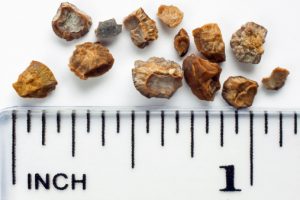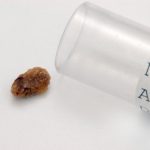 Researchers have found a means for faster kidney stones disease analysis with a method developed using Raman spectroscopy. Kidney stones are often explained as being the most painful sensation a person can endure. They result from hardened mineral deposits within the kidney. If small enough, a doctor will advise you to simply pass them through urination, but if the stones are large, surgery may be required to break them down or remove them.
Researchers have found a means for faster kidney stones disease analysis with a method developed using Raman spectroscopy. Kidney stones are often explained as being the most painful sensation a person can endure. They result from hardened mineral deposits within the kidney. If small enough, a doctor will advise you to simply pass them through urination, but if the stones are large, surgery may be required to break them down or remove them.
The function of the kidneys is to remove waste, including excess minerals. If the kidneys are unable to remove such waste, they can harden and form painful stones.
Advertisement
New spectroscopy method helps analyze kidney stones quickly
 Researchers at the Fraunhofer Institute for Physical Measurement Techniques IPM are developing a new Raman spectroscopy for rapid diagnosis of kidney stones. This technology could lead to improved patient follow-up care and reduce future kidney stones.
Researchers at the Fraunhofer Institute for Physical Measurement Techniques IPM are developing a new Raman spectroscopy for rapid diagnosis of kidney stones. This technology could lead to improved patient follow-up care and reduce future kidney stones.
Researcher Dr. Arkadiusz Miernik said, “Only a small number of kidney stone patients receive a comprehensive consultation and follow-up after they have been treated.” Reasons for this may be in large part due to the cost and time it takes to conduct a follow-up exam. Miernik added, “The patient in most cases has already been discharged and will not be seeing the doctor again. We advise stone patients to drink plenty of fluids, increase physical activities and lose weight if necessary. Unfortunately, this is only a general recommendation. From the clinical point of view we need individualized approaches and these must include results of a compositional analysis of the stone. This allows us to evaluate the individual risk of disease recurrence and detect potential metabolic abnormalities.”
Raman spectroscopy allows doctors to rapidly and effectively characterize and identify kidney stones. With the use of wavelengths they can analyze samples called a “chemical fingerprint.” Miernik explained, “These samples are illuminated using laser light. About 1 percent of the photons are reflected back in a different wave spectrum highly specific to the sample. We record these signals in a database.”
The method is relatively inexpensive and can work on wet, unprepared samples. Furthermore, the time to prepare samples is greatly reduced. Previous methods involved drying out the samples, but the new technology does not require such a process. Unfortunately, there are no compact versions of the device available so the equipment is limited.
Current tests for early detection of kidney stones
It is very important to diagnosis kidney stones early on; not only are they painful, but they can cause complications if they get stuck in the urethra. For starters, x-rays can be used to diagnose kidney stones – this method is about 80 percent effective.
A diagnostic test known as intravenous pyelogram (IVP) is completed with an injected dye that shows up in x-ray images. If there are blockages present, the dye is unable to pass through the kidneys, thus resulting in a diagnosis of kidney stones. Although IVP is reliable, it can have adverse effects due to the dye as well as expose individuals to radiation.
Ultrasound is another means of diagnosing kidney stones. With the use of sound waves – no dyes or radiation are requires – it is safer. The drawback to ultrasound is that ureteral stones often do not show up.
Lastly, a direct means of diagnosing kidney stones involves CT KUB. This requires that numerous images be taken of the abdomen and pelvis. The liver, pancreas, gallbladder and upper digestive organs can all be seen with a CT KUB.
Types of kidney stones
 Kidney stones are caused by an excess of minerals that formed into stones. There are different types of kidney stones based on which mineral is most present.
Kidney stones are caused by an excess of minerals that formed into stones. There are different types of kidney stones based on which mineral is most present.
Calcium stones: Formed from an excess of calcium, in particular calcium oxalate. Hyperthyroidism and certain medications can contribute to an excess of calcium, which can lead to kidney stones.
Uric acid stones: Uric acid commonly comes from red meat. A build-up of uric acid can come from high consumptions of red meat, low urine output, an increase in alcohol consumption, gout and inflammatory bowel disease.
Struvite stones: Struvite stones can occur with a kidney or bladder infection. These stones are typically larger and thus can become more dangerous. Antibiotics may be prescribed to treat the infection and break down the stones.
Cystine stones: A less common form of kidney stones, cystine stones run in families who produce too much cystine in their urine.
Early warning signs of kidney stones
In order to avoid complications associated with kidney stones, it’s important to recognize the early signs so you can be prompted to visited your doctor and begin treatment right away. Here are the early warning signs of kidney stones.
 1. Frequent and painful urinate: Although this can be confused with a UTI, it’s still important you check in with your doctor.
1. Frequent and painful urinate: Although this can be confused with a UTI, it’s still important you check in with your doctor.
- 2. Spreading back pain: Pain may begin on one side of your back, right below your rib cage, and may travel down to the lower back.
- 3. Blood in urine: Blood in urine or stool should always be a red flag, especially if you believe you have kidney stones. Blood in urine can signify a blockage, so medical attention is required.
- 4. Nausea and vomiting: Without your kidneys being able to remove waste you may begin to feel nauseous and even vomit.
- 5. Pungent smelling urine: Unless you had asparagus, odor changes occurring to your urine are an early sign of kidney stones.
- 6. Inability to sit: When sitting or laying down additional pressure is put on your kidneys, making it difficult to stay in these positions.
- 7. Fever and chills: Often results when your body is fighting an illness or infection.
- 8. Swelling: The swelling occurs in the kidney and abdomen.
The quicker you recognize the signs and symptoms of kidney stones, the earlier you can begin treatment and get back to feeling like yourself again.
Related Reading
5 things that increase your risk of kidney stones
Kidney stones are incredibly painful stones which form inside the kidneys. There are many reasons why a kidney stone would develop, such as lack of water, too much calcium build-up and excess uric acid which can occur from a high-protein diet. Continue reading…
Advertisement
Large kidney stones improve with tamsulosin
In an attempt to uncover better treatment for kidney stones, researchers conducted clinical trials of a kidney stone medication called tamsulosin. What they found was on small kidney stones tamsulosin had minimal effect, putting its results on par with the placebo. Continue reading…
Sources:
http://phys.org/news/2015-10-rapid-analysis-kidney-stones
http://www.healthcommunities.com/kidney-stones/radiology-diagnosis
http://www.webmd.com/kidney-stones/tc/types-of-kidney-stones-topic-overview
http://www.activebeat.com/your-health/8-early-warning-symptoms-of-kidney-stones
